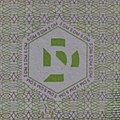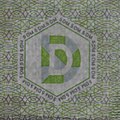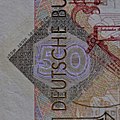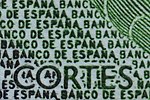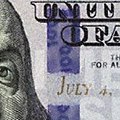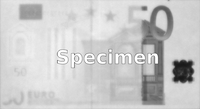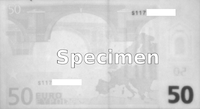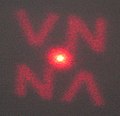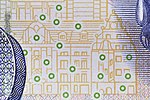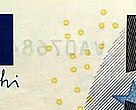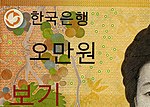Security features of banknotes
As security printing defined are safety features referred to specific substrates for banknotes use and are equipped with features, making them doubt of counterfeit money can be distinguished. By introducing a large number of such features, counterfeiting is made considerably more difficult or even impossible. The production takes place during the production of the substrate as well as in security printing works under security conditions in mostly specialized companies.
There are more than 100 different security features for banknotes worldwide. These are subdivided into security features that can be recognized by humans (also called human features ) and machine-readable features that have been developed since the advent of machine banknote processing in 1970. Only some of all the features are publicly known because the issuing central or national banks keep information on the highest-quality security features secret and reserve it for themselves in order to make copying more difficult. For reasons of cost and space, the currencies are only equipped with specifically selected security features, and the high denominations or nominal values mostly with higher-value and additional features.
Human recognizable features
Banknotes such as the euro and the Swiss franc have many optical , haptic and acoustic security features so that people can check their authenticity without tools. The European Central Bank recommends the Feel - See - Tilt procedure : First, the tactility of the banknote (including the substrate) should be checked, then the optical design and finally the behavior of certain optical features during a tilting process (towards the incident light) .
From an economic point of view, counterfeiters often only imitate individual features with sufficient accuracy and neglect those which, in their opinion, are seldom checked or which require more time. A multi-stage procedure - as described above - therefore significantly reduces the probability of accepting counterfeit money unnoticed.
In order to be able to distinguish counterfeit money, it is first necessary to know about the basic appearance of a real banknote and its properties. Therefore, the introduction of a new banknote series is usually accompanied by information campaigns describing the design and basic security features, so the marketing complicate of fancy fakes. Therefore, many central banks provide free apps for mobile devices available to explain the banknote design and recognizable human security features. However, banknotes recorded with the camera can in no way be checked for authenticity, but are only used for the interactive explanation of the checkable security features. Therefore, simple banknote images or screen displays are sufficient for demonstration and training.
Examples of banknote apps:
- Swiss francs with interactive 3D effects as augmented reality
- Malawi-Kwacha with interesting simulations for tilting and feeling effects as well as interactive 3D effects as augmented reality
- South African rand as an offline explanation and augmented reality application
- Emalangeni from Swaziland with interesting simulations for tilting and feeling effects as well as interactive 3D effects as augmented reality
Substrate
Banknotes are printed on a special substrate. It is mostly about special paper, in the beginning rag was used. Banknote paper is mostly made on the basis of cotton seed hairs (linters), which are obtained in an environmentally friendly manner from waste from textile production. Substrates made of cotton have the advantages that they are not destroyed by accidental washing processes and heat, have a special "paper feel" and are stronger than standard cellulose- based papers . The exact composition of the paper is not published as a security feature and it is only sold to banknote printers. In addition, linen (for the US dollar ) or banana hemp (for the Japanese yen ) as an alternative natural raw materials used in the substrate.
In many cases, the banknote paper is colored differently depending on the denomination in order to make counterfeiting more difficult. The euro banknotes of the first series, for example, use gray (€ 5), red (€ 10), blue (€ 20), orange (€ 50), green (€ 100) and yellowish brown (€ 200), each with a paler color Coloring.
One of the leading manufacturers of security paper is the Louisenthal paper factory , a subsidiary of Giesecke + Devrient , with production facilities in Gmund am Tegernsee and Königstein (Saxon Switzerland) . In addition, there are many paper mills operated by the central banks.
An alternative to renewable raw materials are polymer-based substrates made from biaxially oriented polypropylene (BOPP) based on Guardian or Safeguard. In some respects, such plastic banknotes show better wear and tear than cotton-based notes. They are more water resistant and are better suited for humid regions of the world. The disadvantage is that polymer banknotes are sensitive to heat and production is significantly more expensive. In addition, the uniqueness of the paper feel and the relief-like embossing due to the steel engraving are lost as haptic security features. Polymer banknotes have been in circulation in Europe for the Romanian leu since 1999 and for the British pound since 2016 . There were individual further editions from the Isle of Man and in Northern Ireland from the Northern Bank. Outside Europe, polymer banknotes can be found mainly in tropical and subtropical countries as well as with the Canadian dollar .
Further developments since 2010 have therefore been using multi-layer substrates made of plastic and paper in order to improve durability and combine the advantages of paper and plastic. These include the Durasafe substrate from Schweizer Landqart in Landquart GR , on which the ninth series of the Swiss franc has been produced since 2016, and the hybrid substrate from the Louisenthal paper mill, which u. a. used for some denominations in Jamaica, Bhutan, South Africa and Armenia.
Banknote format
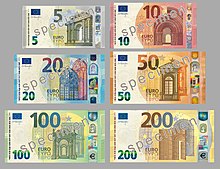
Most currencies use different dimensions of length and / or width for the denominations, smaller formats for the lower values, and larger formats for the larger values. This should make forgery by manipulating the value number more difficult. The euro of the first series (ES1) used formats from 120 mm × 62 mm (5 €) to 160 mm × 82 mm (500 €), the Europe series (ES2) reduced the largest format to 153 mm × 77 mm (through Elimination of the 500 € and reduced width to 100 € and 200 €). The eighth series of the Swiss franc used the same width of 74 mm with different lengths from 126 to 181 mm. For the ninth series, the width has been reduced to 70 mm and the length to a range from 123 to 158 mm. In general, there is a tendency to downsize banknote formats in order to reduce manufacturing costs and to reduce the risk of damage to small purses .
The US dollar uses a uniform format of 66 mm × 156 mm, so that, for example, a 5-dollar banknote can be falsified into a 50-dollar banknote with little effort by adding a zero to the value number, especially since the design and color of all denominations are similar.
Tactile and acoustic features
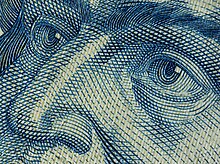
Haptic or tactile perception through the sense of touch can be easily felt , especially with paper-based substrates, through the roughness or embossing of the surface and the steel engraving . In the case of banknotes on a polymer substrate (plastic banknotes), these effects are only weakly pronounced.
Paper feel
The haptic impressions of security papers are achieved through the special composition of the cotton-containing fibers in the substrate. They differ significantly from standard cellulose-based writing or printing paper.
Embossing
When printing banknotes, the steel engraving gravure printing process ('intaglio') is almost always used. It is ink under high pressure of several thousands of bar transferred onto the paper so that a tactile relief occurs and the ink penetrates deep into the paper. The Euro banknotes of the Europa series (ES2) also have short raised lines embossed on the left and right edges, which make it easier for blind or visually impaired people to tactile differentiation of the denominations.
Acoustics
The sound of banknote paper when it is crumpled or rubbed is influenced by the paper fibers in the substrate and by the printing process. Banknotes sound “harder”, especially if they are printed on both sides with a steel engraving and have not become limp through long use.
Visible features
The basic safety features (so-called level 1 ) can be recognized directly by humans and checked without further aids. As a rule, these features are not used for machine authentication, but their condition is checked whenever possible.
Optical security features are the open clear characteristics of a banknote. The knowledge that banknotes contain watermarks that can be easily seen against the light or that security strips are incorporated into the paper is widespread. In addition to the security features that are visible in normal ambient light, there are other security features that change depending on the viewing angle, such as iridescent printing inks and foil elements .
- Visible banknote image
Watermark
Watermarks are incorporated in paper production using different paper thicknesses. They can usually be found in the unprinted areas. In backlight the thinner parts brighter with a dark background, however, appear darker. Only this comparison allows a reliable distinction to be made between real watermarks and fake watermarks which imitate the impression of a watermark with an imprint. Real watermarks can only be produced with great effort and are therefore a very reliable feature of authenticity. Watermarking methods are also used to stiffen banknote corners to reduce dog-eared ears and cracks, including the like. a. as Cornerstone and Edgestone .
- Watermark
Watermark in a 5 DM banknote (BBk-I) (1961)
Watermark in a 50- franc banknote (8th series) (1995)
Queen Elizabeth II as a watermark on a £ 5 banknote (2002)
See-through window
In banknotes that use transparent polymers as a substrate , see-through windows can easily be provided by locally omitting the white coating for ink acceptance and overprinted with a pattern. This safety feature was used in the first series of banknotes, such as the Bulgarian 20 leva -Note, the Australian dollar bills , the Romanian leu , the recent Chilean 2000 pesos -Note, the Mexican 20- and 50-peso bills or some Singapore Dollar -Grades. However, due to the increasing capabilities of commercially available inkjet printers with special inks for printing on plastics , this optical security feature could be imitated more and more easily and therefore no longer offered adequate protection against counterfeiting. Newer banknote series based on polymer substrates therefore additionally cover the transparent area with thin film elements that are secured with holographic processes, possibly differently on the front and back. Examples include the 2011 Canadian dollar (“Innovation”) and the Australian dollar (2016 series).
A similar effect can also be achieved with banknotes based on cotton fibers or other natural fibers. Here, holes with a specified contour and an area of up to 300 mm² are punched out in the substrate and pasted over on both sides with a thin film element. The Euro banknotes of the Europa series (ES2) use this high-quality security feature for denominations of 20 euros or more. It is known as the portrait window, is transparent when viewed against the light and appears on both sides of the banknote as a portrait of Europa, which is also equipped with holographic elements as copy protection.
- See-through window
See-through register and register printing
See-through registers (see-through register) consist of complementary patterns on the front and back, which only give the overall picture in backlight . Examples of this are the Swiss cross, the D on the last D-Mark banknotes or the value number on the euro banknotes of the first series (edition from 2002). See-through registers are difficult to reproduce because the highest accuracy of the register is required when printing on both sides. It has the advantage that even small inaccuracies by the counterfeiters are easier to spot.
- See-through register
See-through register of a 1000 Escudo banknote (see-through)
Transparency register of a 50- franc banknote (8th series) (transparency)
In register printing, different patterns or symbols are printed on top of or on top of each other so that together they result in a recognizable image. The smallest deviations due to inaccuracies in register can be recognized with the naked eye, as the image appears distorted.
Foil elements
By inserting or applying film elements, an optical and difficult to reproduce surface marking is achieved. Kinegrams and holograms are patterns produced by printing technology that are incorporated as metal / plastic foils. They represent an appearance that depends on the viewing angle and imitates two- and three-dimensional images or sequences of movements . In the Europa series, 100 and 200 euro banknotes use a satellite hologram that moves small € symbols around the value when tilted. Foil elements can also be combined with a see-through window.
Three-dimensional effects, such as B. curvatures or a displacement of three-dimensional objects are produced with micromirror technology. A great many tiny mirrors (approx. 40,000 per mm²) are aligned and embossed into the material in such a way that the sum of their reflections results in an image that appears to move dynamically as soon as you change the tilt angle of the banknote. Such films are manufactured by G + D for the RollingStar security thread.
- Foil elements
RollingStar Security Thread in a 500 Dram Armenian Banknote (2018)
Guilloche and iris print
As Guilloches curving pattern are indicated by fine lines. They consist of wave and loop patterns printed one on top of the other in different colors. In order to prevent the lines from being separated for forgeries, these are often in cloudy tones.
With iris printing, a color gradient is generated on the cutting lines of differently colored guilloches or other suitable printing elements by appropriate printing machines. This is difficult to reproduce in the exact process using color copiers.
Anti-copy grid
An anti-copy raster is a very finely resolved raster image . If the scanning resolution is too low , as is the case with copiers , the fine raster elements cannot be reproduced completely. As a result, image elements are lost, and sometimes noticeable moiré patterns are created . Similar properties are also created with guilloches and microscripts . In particular, counterfeit copies can easily be recognized with the aid of inkjet printers and laser printers because they cannot display such high resolutions.
Mottled fibers
Colored fibers are added to the paper ; with appropriate coloring, mottled fibers can glow in different colors under UV light (see #Fluorescent colors )
Micro perforation
Micro- perforation is available as micro- perf on the Swiss franc and the Romanian leu . The smallest holes are punched in the substrate or in a foil element without creating a “crater”. In the backlight, the holes usually form into a pattern, e.g. B. the value of the Swiss franc.
Microtext
Many banknotes have text in micro- font, i.e. the smallest font. These lettering are difficult to see with the naked eye. On the euro banknotes, they are incorporated into the motifs as picture elements. The micro-writing can be read with a magnifying glass. Micro-fonts can be created with special CTP imagesetters for steel engraving or offset printing machines. The image resolution of commercially available imagesetters or even that of inkjet printers is too low for reproduction. The micro-writing on the front of the D-Mark banknotes (BBk-III / IIIa) is only ¼ mm high.
- Enlarged microscripts
1,000 pesetas banknote (front)
Optically variable printing ink
In the optically variable ink (engl. Optically Variable Ink , abbr. OVI) changes the color impression depending on the viewing angle by the light on the pigments broken, scattered or reflected. In the last series of D-Marks, the lower part of the large value number was printed on the front of the 500 and 1000 Mark notes with optically variable printing ink. This security feature is also used on the back of the four largest euro banknotes (ES1 series). There the value number in the white field changes from purple to olive brown.
In the Europa series (ES2) the OVI security feature is used as a further developed emerald number on the value number on the front. When the banknote is tilted, a light bar moves up and down and the color changes from emerald green to deep blue depending on the perspective. There are also € symbols on the emerald number on the 100 and 200 euro banknotes.
- OVI effects
Pearlescent strips
Pearlescent strips are printed with transparent varnish (Iriodin) and, similar to optically variable printing inks, change their color when the banknote is tilted. In the first Euro series (ES1) it is used for the small denominations (up to € 20), in the Europe series (ES2) for everyone. When the banknote is tilted, the pearlescent strip becomes visible or invisible (with the euro symbol and the respective value) with a shiny golden shine.
- Pearlescent strips
Security thread
The security thread is usually a 1–2 mm wide metallized strip that lies within the paper, since it is already incorporated into the paper pulp during the production of the substrate. An improved variant is the window security thread, which is exposed in sections by reducing the paper thickness like a watermark. In addition, it can be provided with an imprint or lasered marking or other optical or invisible properties. Usually the position of the security thread is varied cyclically in a certain area of up to 10 mm when it is inserted, so that the differences in thickness of the banknotes are distributed over a larger area.
The security thread Motion produced by the US American Crane Currency is approx. 5 mm wide and was first used in 2006 on the 1000 kroner banknote of the Swedish Reichsbank and since 2009 also on the 100 US dollar banknote. In the meantime there are many further developments of such embedded security threads with color gradients dependent on the direction of view and other optical effects. Using lenticular technology , a three-dimensional movement effect is created, which is now also possible with foil elements.
Security threads cannot be reproduced by printing technology or, in the case of forgery, by photocopy. Due to their production, they are not possible on a polymer substrate and are at most simulated by a similar print. In some countries there is a custom of tearing the banknote near the security thread in order to check whether there is actually a thread there.
- Security thread
US $ 100 banknote window security thread (2009 series) with motion
Custom colors
For printing, special colors are used in some areas that are outside the color space of a CMYK printer and therefore cannot be reproduced in a true -to- color manner. Other color levels are outside the RGB color space and are therefore not correctly recorded by a scanner, so that forgeries and real banknotes can be clearly distinguished visually.
serial number
The serial number is a characteristic part of all banknotes. Its primary purpose is to control the amount of banknotes produced and to clearly identify each banknote in circulation within a series and a denomination. As a rule, it consists of a few letters and many digits to enable a range of values that is billions of times over. The serial number can also contain a check digit . The check digit is primarily used to identify errors when reading the serial number automatically. In special cases, recorded serial numbers can be used to identify the perpetrator by identifying ransom payments, such as B. was successful in the kidnapping of the Lindbergh baby by Bruno Richard Hauptmann and the kidnapping of Richard Oetker by Dieter Zlof . Comprehensive tracking of banknotes during deposits or withdrawals is technically possible, but is not sought by most central banks due to the protection of privacy and anonymity , since the connection between a possible crime and the current owner of a banknote assigned to the crime by serial number is difficult and can be proven in individual cases.
Often the serial number is printed with OCR-B and constant character size (such as with euro banknotes). For some currencies, however, different character sizes are used within the serial number. With laser engraving , the characters can be applied in any size and orientation. In the 1980s, the Dutch guilder was printed with a barcode as a serial number for machine reading.
Most currencies have the same serial number printed on the left and right halves of the banknote. This is used to identify manipulated banknotes that are composed of different parts. As a rule, a banknote is only considered genuine and redeemable if it consists of at least 50% one piece. For reasons of space, the second serial number for the Euro banknotes of the Europa series has been rotated by 90 ° and shortened to the last six characters.
The serial number is only suitable to a limited extent as a security feature and is only useful for simple counterfeiting when several counterfeit banknotes have identical serial numbers. Professional counterfeits use variable serial numbers with the correct check digit.
- Serial numbers on banknotes
200 Quetzales banknote from Guatemala with lasered serial number (in white field)
Vietnamese Đồng (series 2004) with two serial numbers
Iranian rial with Arabic script and Arabic numerals
Features recognizable with simple tools
Test pins
Special test pins can be used to quickly determine the strength of the paper substrate. While real banknotes hardly or not at all discolour, counterfeits turn black immediately. This not very safe method - there is no color change on newsprint - is often used in retail outlets for reasons of cost and time.
Color pairs
By using metamerism (color pairs), visually the same color tones are printed that hit the same place in the CMYK color space.
Through the use of invisible admixtures, the color pairs can be differentiated using optical testing devices (e.g. in the IR range) and designed as a machine-readable feature. For example, cloudy pairs of colors can be achieved with and without a black component. Due to the soot in the color line with the black component, this is visible in the infrared light, while the color lines mixed from the chromatic colors become invisible.
- Viewing a 50 euro banknote (ES1) in infrared light using an IR filter
Fluorescent colors
Basically, banknote substrate is produced without optical brighteners , in contrast to most types of paper. The substrate is therefore UV-matt and does not react to UV lighting. However, if it is accidentally washed with heavy-duty detergent containing brightener, it can fluoresce and therefore incorrectly indicate a suspicion of counterfeiting when UV testing devices such as those often used in retail checkouts are used.
In addition, printing inks containing fluorescent pigments are used. In short-wave UV light, colors in the visible light spectrum are emitted through luminescence , depending on the choice of pigment . The used wavelength of the excitation can produce different results of the fluorescent color. Fluorescence can also be possible when illuminated with (monochromatic) light in the visible range up to the infrared. Special viewing devices can be used for this. Methylene blue, for example, offers infrared fluorescence.
- Fluorescence of the 50 euro banknote (ES1) under UV lighting
Diffractive optical element
A diffractive optical element (DOE) is engraved into an optically milky film in the see-through window of the substrate . It is based on diffraction effects through an optical grating and can be made visible with a laser pointer by projecting it onto a plane. It was originally developed as a watermark substitute for polymer banknotes, but handling proves to be cumbersome in practical use.
Scrambled Indicia
Scrambled Indicia is the name given to the micro-print pattern that can only be recognized as an image using a decoding lens. However, no application in banknote production is known to date.
Machine readable features
The machine-readable security features for commercial requirements (so-called level 2 ) are used to assess the authenticity of banknotes for deposits at ATMs , ticket machines and vending machines . According to the requirements of the European Central Bank (ECB), the devices used for this must meet minimum requirements with regard to their performance for counterfeit money detection . Credit institutions and other cash handlers may also re-issue banknotes through cash recycling if they have also checked their fitness.
The central banks also use secret machine-readable security features with the highest requirements for the security of authenticity detection (so-called level 3 ) to ensure the integrity of the cash cycle and to only return guaranteed real banknotes to circulation or to destroy them in a controlled manner if they are fit for circulation due to Soiling and wear are no longer sufficient.
There are the following principles of machine-readable features (selection):
Infrared properties of the printing ink
Printing ink is used that is only "visible" to devices with suitable sensors under infrared radiation . Almost all banknotes are equipped with this security feature.
Phosphorescent color
Color pigments that are excited by UV radiation and afterglow as phosphorescence for a very short time (typically <5 ms) . The detection requires special light-sensitive sensors.
M feature
The composition of the M-Feature is only known to the European Central Bank and, according to its information, is a reliable means of distinguishing forgeries from real banknotes. Depending on the structure of the cash cycle (and the denomination), the national banks of the euro countries check the authenticity and fitness for circulation every few months (e.g. Deutsche Bundesbank ) or more than a year (e.g. Banco de Espana , Banca d'Italia ).
Magnetic elements
The printing ink used in US dollar banknotes and many other banknote series contains magnetic pigments that can be detected with appropriate sensors. With some banknotes only the (mostly black) serial number is marked with magnetically pigmented printing ink. The magnetic pigments are similar to the coating on magnetic tapes.
Electric conductivity
Certain elements of the banknote such as the security thread can be electrically conductive . Printing inks and film elements can also be made conductive by using appropriate particles or coatings.
copy protection
A standardized pattern of small circles, known as the EURion constellation or "Omron rings", can be recognized by scanners and copiers, making digital reproduction on these devices difficult or impossible. This procedure is now used worldwide. Alternatively, a digital watermark can also be used.
- Banknotes with Omron copy protection (EURion constellation)
literature
- Jürgen Bartholomäus, Eduard K. Liedgens: Counterfeit money detection. 4th edition. Bank-Verlag , Cologne 2005, ISBN 3-86556-107-1 .
- Laurie Winkless: How to make money , in: Business Life, July / August 2016, pp. 30–34. [1]
Web links
- Banknote security features. (PDF; 12 MB) In: Billetaria, Issue 16. Banco de Espana , October 2014, pp. 46–47 , accessed on June 13, 2019 (English): “A catalog of the main banknote security features recognizable by the public and currently in use worldwide. The features have been grouped according to their common functional properties for detection by the general public and retailers. The picture of each feature is accompanied by a brief explanatory text. "
- Police: counterfeit money in circulation. Retrieved April 27, 2019 .
- ECB Eurosystem: Security features € 100 banknote from the Europa series. Retrieved April 22, 2019 .
- Swiss National Bank: An overview of the security features. Retrieved April 27, 2019 .
- US Currency Education Program: The Seven Denominations. Accessed April 27, 2019 .
- Bank of England: take a closer look. (PDF; 3.29 MB) February 22, 2018, accessed April 28, 2019 (English).
Individual evidence
- ↑ ECB Eurosystem: Security features € 100 banknote from the Europa series. Retrieved April 22, 2019 .
- ↑ a b Currency App: New, interactive presentation of banknotes. Giesecke + Devrient Currency Technology, accessed on May 16, 2019 (de;, English, with video for demonstration and access to download currency apps).
- ↑ Swiss National Bank provides banknote app. (PDF; 58 kB) Experience the new 50-franc note on your mobile device. Swiss National Bank, April 12, 2016, accessed on May 6, 2019 .
- ↑ Orama Chiphwanya: Malawi kwacha app to curb counterfeit currency. The Nation, February 1, 2019, accessed May 6, 2019 .
- ↑ SARB Currency Mobile App. South African Reserve Bank, accessed May 6, 2019 .
- ↑ Louisenthal paper factory: Banknote paper - a portfolio of substrates for every face value. Retrieved April 28, 2019 .
- ↑ CCL Secure: Guardian - Facts and Figures. Accessed April 28, 2019 .
- ↑ De La Rue Safeguard: Proven Polymer Integration. In: De La Rue. Retrieved May 6, 2019 .
- ↑ Landqart: Durasafe. Retrieved April 28, 2019 .
- ↑ Hybrid banknote substrate. In: Louisenthal paper mill. Retrieved August 7, 2019 .
- ↑ Cylindrical screen watermark - the best-known security feature in banknotes. In: Louisenthal paper mill. 2015, accessed August 7, 2019 .
- ^ Banknote Paper: Cornerstone and Edgestone. Cost effective durability. (PDF; 108 kB) In: Portals. Retrieved August 7, 2019 .
- ↑ The new 100 euro and 200 euro banknotes. (PDF; 6.0 MB) Deutsche Bundesbank, September 1, 2018, accessed on May 6, 2019 .
- ↑ Small mirrors, big effects. In: Giesecke + Devrient . Retrieved on September 11, 2019 (information on RollingStar security thread and varifeye ColourChange films).
- ↑ Christian Siedenbiedel: The digitization of cash. Should one save the serial numbers of the banknotes and their routes on the net in order to fight crime? The Bundesbank is skeptical. Frankfurter Allgemeine Zeitung, June 28, 2019, accessed on July 4, 2019 .
- ^ Digital Document Security. (PDF; 4.64 MB) HW Sands Corp., Graphic Security Systems Corporation, pp. 7-11 , accessed on June 15, 2019 .
- ↑ ECB Eurosystem: Tests of devices for checking the authenticity of banknotes. Retrieved April 22, 2019 .
- ↑ ECB Eurosystem: re-issue of banknotes by credit institutions and other cash handlers. Retrieved April 22, 2019 .
- ↑ Deutsche Bundesbank: The banknote cycle and banknote recycling in Germany, in: Monthly Report January 2011, p. 19 ff. (PDF; 284 kB) January 2011, accessed on April 22, 2019 .















